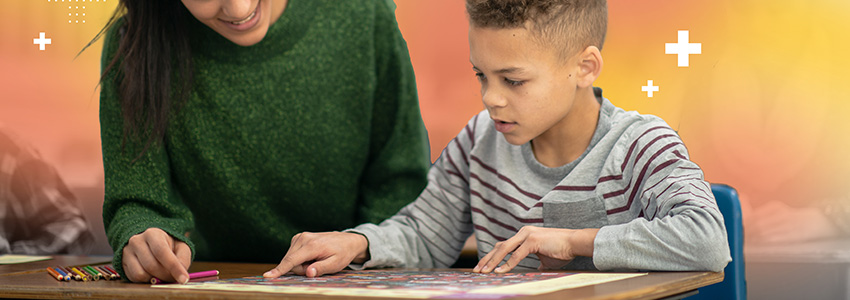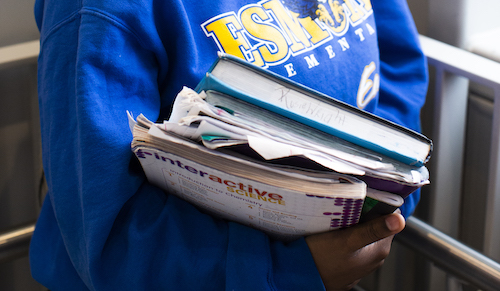 In our webinar Straight facts on dyslexia: What the research actually tells us, NWEA literacy expert Tiffany Peltier demystifies the most common learning disability in one evidence-based, interactive hour.
In our webinar Straight facts on dyslexia: What the research actually tells us, NWEA literacy expert Tiffany Peltier demystifies the most common learning disability in one evidence-based, interactive hour.
Get ready to flex your literacy muscles as Tiffany offers simulations of dyslexia, helpful metaphors, and essential myth-busting. At the end of this comprehensive hour, she spends time answering questions from the chat—which was hopping! I sat down with Tiffany after the webinar and (re-)asked her nine of the most common questions because, hey, the learning process includes unlearning and relearning, too.
1. What is dyslexia?
Dyslexia is when a student has greater difficulty with learning to read words than their peers. A dyslexia diagnosis observes the three-criteria approach and occurs when A, B, and C are present:
- Difficulty reading words accurately and/or fluently
- A comparative lack of improvement amongst their peers when provided with generally effective support in these areas
- The difficulty is not accounted for by something else, like an intellectual disability or the need for glasses
Quite simply, “dys” means “difficult,” and “lexia” means “word.” If a student has trouble reading the words off a page or spelling them, the scientific name for this is dyslexia.
2. What is dyslexia NOT?
Dyslexia is not a visual difficulty or disability. Dyslexia does not mean that a student’s eyes perceive words or letters backward or flipped. (In fact, many strong readers initially flip their letters!) Eye doctors cannot identify dyslexia. Colored lenses or overlays, eye-tracking exercises, or special fonts are not proven to help with dyslexia.
When we believe the misconception that dyslexia is a visual disability, we will fail our students as we treat it ineffectively. Read more about dyslexia myths in Tiffany’s article “Unraveling dyslexia: Dispelling myths and understanding early intervention.”
3. Why should dyslexia be identified in schools, rather than by outside specialists?
Because of the second criteria (low response to generally effective intervention), dyslexia is identifiable only in context of the lack of growth in targeted areas even though the intervention is generally effective for other students with similar difficulties. An outside specialist does not have the context over time that is needed to evaluate if a student has received targeted intervention and is still not showing the same growth as other students. Dyslexia doesn’t show up in an eye exam or a brain scan; it is a comparative diagnosis and needs more context than an outsider can provide.
Imagine this: Safi’s parents are worried he isn’t reading on grade level, so they take him to a specialist. The specialist agrees that, indeed, Safi cannot read the third-grade text provided. However, what the specialist doesn’t know is that Safi wasn’t provided with much explicit phonics instruction in the early grades, and he hasn’t been provided any additional instruction or targeted support yet because he just switched schools and the teacher has just noticed Safi is behind. Safi may not have dyslexia; he may simply need some extra help!
4. Can dyslexia show up later in students?
Not really, but it can be caught later. Because dyslexia is a difference in the brain, it’s likely present for a student’s entire life. Having it “show up later” most likely means that a student wasn’t identified as having dyslexia. This can be due to changing schools, educators having an incomplete reporting system to rely on, or any other factors that may have disenfranchised a student.
5. Conversely, can a student “overcome” dyslexia?
Dyslexia is a neurological difference in the brain that affects how information is processed and, thus, cannot be “cured” in the typical sense. However, dyslexia can be managed and skills improved with the right intervention and supports. Students can be supported in stocking their toolbox with reading strategies that will allow them to succeed academically.
6. What do we do with older students who we suspect of having dyslexia but were never formally diagnosed?
Unfortunately, many components can cause a late dyslexia diagnosis in an older student. Identification of dyslexia, more commonly referred to as an SLD (specific learning disability) in basic reading skills within public schools, will help them get the extra support they need to catch up to their peers.
Remember, a dyslexia diagnosis consists of three criteria: difficulty with reading and spelling, low response to intervention compared to their peers, and the consideration of exclusionary factors. It may be that this older student does need support, but if offered focused, targeted intervention, would recover quickly and thus evade a dyslexia identification.
If an older student does have dyslexia, the same interventions apply as in younger students.
7. What do I do about spelling tests and students with dyslexia?
Dyslexia is any difficulty in word-level reading difficulties. This includes phonics, spelling, and reading fluently. Students with this difficulty need both intervention and accommodations when it comes to reading words fluently and spelling, consistent with their school’s MTSS.
Since spelling (encoding) is the reciprocal of reading words (decoding), spelling will also be a challenge for students with dyslexia. For spelling tests in general, teachers should use that data to plan instruction formatively for the next week. Gone are the days of giving students a list of words on Monday and quizzing them Friday! The best practice is to teach students a specific phonics and spelling skill and use words Friday that include that skill to see if students have mastered the pattern. If so, move to the next skill with those students and hold them accountable for using this skill in their future writing. If not, ensure students continue to receive practice on that skill along with the next skill. In their writing, remind them and provide scaffolds for sounding out and spelling words. For older students, ensure they can show what they know on writing assignments without counting off for spelling patterns they are still working on mastering. Some students can also benefit from an accommodation, like speech to text, to help them show their skills in writing without spelling becoming a barrier.
8. What are the differences between dyslexia, dysgraphia, and developmental language disorder (DLD)?
Dyslexia and dysgraphia are both learning difficulties, but they affect different skills. Dyslexia is a difficulty that affects a student’s ability to read and decode words. Dysgraphia is a difficulty that impacts handwriting. Students can have both conditions, but one does not cause the other.
Developmental language disorder (DLD) is difficulty with understanding and using language. DLD can influence how a person comprehends what they hear and read. People with DLD might have trouble finding the right words, expressing themselves, understanding directions, engaging in conversation, organizing thoughts in writing, or answering questions. In the Simple View of Reading, DLD describes a difficulty with the language comprehension part of the equation while dyslexia describes a difficulty in the word recognition part of the equation.
It’s possible for a student to have dyslexia, dysgraphia, and DLD.
9. How does dyslexia manifest with ELL students and what are some steps I can take?
Dyslexia in multilingual learners (MLLs) is identified in the same way as for other students: greater difficulty learning to read and spell compared to peers with similar skill levels and language proficiency who receive the same interventions. This would manifest as a slower pace in learning to read and spell in both languages, if students are learning to read in both English and Spanish, for example. Differences in sound-spelling patterns, like the letter Arepresenting different sounds in Spanish and English, can add to the challenge and cause initial confusion.
To support MLLs with dyslexia:
- Provide explicit instruction in sound-spelling patterns with extensive opportunities to respond with positive and corrective feedback
- Incorporate visuals, gestures, and examples connecting English concepts to their home language
- Monitor progress with assessments in both languages, when possible, and evaluate growth compared to peers with similar language proficiency, intensifying the intervention dosage as needed
- Celebrate and integrate their cultural and linguistic background knowledge and point out similarities and differences with their home language
Dyslexia and assessment
If you’re interested in assessing early readers while also screening for dyslexia, MAP® Reading Fluency™ can help. Visit our website to learn more. You can also read the archive of posts about getting the most out of MAP Reading Fluency here on Teach. Learn. Grow.







